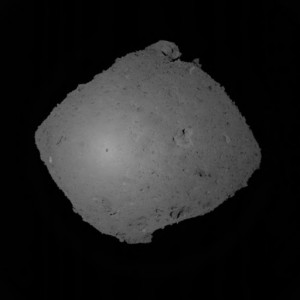Hayabusa2’s Amazing Close Encounter With Asteroid Ryugu
Posted on Categories Discover Magazine

Hayabusa2’s view of Ryugu as the craft descended towards the asteroid October 15, 2018 in the first of two touchdown rehearsals. (Credit: JAXA)
This past summer, Hayabusa2 — a spacecraft, operated by the Japanese Space Agency JAXA, sent to collect and return asteroid samples — arrived at asteroid Ryugu. Today, the craft comes close to the asteroid in the first of two touchdown rehearsals.
After reaching the asteroid on June 27, Hayabusa2 primarily observed Ryugu from “The Home Position,” which is a position about 65,617 feet (roughly 2,000 meters) away from the asteroid. Today, Hayabusa2 is descending to only 82 feet (25 meters) from the asteroid’s surface.
After this close brush, the spacecraft will retreat. This is the first of two touchdown rehearsals before “conjunction” — “when Ryugu is behind the Sun as seen from Earth,” Jonathan McDowell, an astronomer at the Harvard-Smithsonian Center for Astrophysics who tracks exciting activity in space, tweeted. During conjunction, it will be very difficult for the craft to communicate with Earth, so activity will slow down from November until January, McDowell added.
‘conjunction’ is when Ryugu is behind the Sun as seen from Earth – this makes it hard for Hayabusa-2 to communicate with Earth, so activities will stand down for a couple of months over Nov-Dec and resume in Jan.
— Jonathan McDowell (@planet4589) October 15, 2018
Hayabusa2’s incredible descent towards Ryugu has revealed a number of amazing images. In the image below, tweeted by the official JAXA Hayabusa2 account, you can see the spacecraft at about 115 feet (35 meters) from the asteroid, its shadow clear on Ryugu’s surface.
[TD1-R1-A] Image received on the ground on October 15 at about 22:52 JST. pic.twitter.com/aO9AbGBPRq
— HAYABUSA2@JAXA (@haya2e_jaxa) October 15, 2018
Minutes after this photo was taken, Hayabusa2 reached its targeted lowest altitude, and “applause erupted in the control room!” the official account tweeted.
[TD1-R1-A] When it was announced that the spacecraft had reached the targeted lowest altitude, applause erupted in the control room! The state of Hayabusa2 is nominal. #AsteroidLanding
— HAYABUSA2@JAXA (@haya2e_jaxa) October 15, 2018
Hayabusa2 is JAXA’s second sample mission. Over the course of its mission, the spacecraft, which launched in 2014, will deploy a small lander and three rovers onto asteroid Ryugu — so far the craft has deployed three rovers to probe the asteroid. The craft will also blast a small crater into Ryugu so it can analyze the materials beneath the asteroid’s surface. After Hayabusa2 has thoroughly studied asteroid Ryugu, it will return to Earth with a number of precious samples on board.
Studying asteroids like Ryugu can give scientists an intimate look at our early solar system. Objects like asteroids have remained relatively unchanged since they formed in the earlier days of the solar system, and those less-changed or unchanged components that an asteroid has retained could clue scientists into how such an object formed, and what may have been happening in the solar system at that point in time.